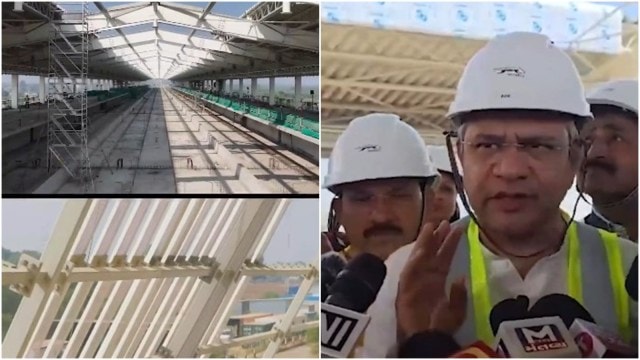Mumbai-Ahmedabad bullet train will convert cities on route into ‘one big economic zone’ on lines of Japan: Ashwini Vaishnaw
With the high-speed rail corridor in place, those in Ahmedabad will be able to have fafda and dhokla for breakfast, leave for Mumbai and return in the evening to be with their children, said Railway Minister
 Vaishnaw said that the bullet train will allow professionals and traders from the cities en route to travel on a daily basis from Ahmedabad to Mumbai. (Photo: Screengrab from Video by X/@AshwiniVaishnaw)
Vaishnaw said that the bullet train will allow professionals and traders from the cities en route to travel on a daily basis from Ahmedabad to Mumbai. (Photo: Screengrab from Video by X/@AshwiniVaishnaw)The upcoming Mumbai-Ahmedabad high-speed rail corridor bullet train project will convert the cities that are part of the project into “one big economic zone” the way six cities of Japan benefited from the first bullet train between Osaka and Tokyo, Union Railway Minister Ashwini Vaishnaw said on Saturday.
Vaishanaw emphasised that the bullet train project was “not just a means of transportation” but a project to develop the entire corridor as an economic zone.
Speaking to media persons at the under-construction Anand bullet train station, Vaishnaw said, “When the first bullet train started between Osaka and Tokyo in Japan, all six cities located on the route became a big business hub, including Nagoya and Kyoto. They became big industrial hubs and residential hubs as new growth happened. Similarly, the Mumbai-Ahmedabad corridor has cities like Thane, Vapi, Surat, Bilimora, Vadodara, Nadiad-Anand and Ahmedabad. It will bring about so much growth that these individual economies will become one big economy…”
Vaishnaw said that the bullet train will allow professionals and traders from the cities en route to travel on a daily basis from Ahmedabad to Mumbai.
Vaishnaw said, “Those in Ahmedabad can have fafda and dhokla for breakfast and leave for Mumbai; and return in the evening to be with their children. Likewise, people from Mumbai will have poha for breakfast and leave for say Surat to complete their work and return to Mumbai for evening snacks with their children. The bullet train is not a mere transportation project. It is a project to develop five-six cities as an economic zone.”
Vaishnaw inspected the ongoing work on the steel bridge that crosses over a busy highway along with the under-construction Anand Bullet Train station as well as the track slab-manufacturing facility and the Track Construction Base (TCB).
The Union minister stressed that a major portion of the bullet train project is an example of “Make in India”. The minister further said that with the bullet trains expected to run at a speed of 350 kilometers per hour, the construction has been undertaken keeping the “pressure zone” in mind.
Vaishnaw said, “When trains run at a high speed of 350 kmph, a pressure zone is created and the construction has to be done keeping in mind its considerations. Therefore, at stations, the entire roof cannot be covered and a vacant space has been created to deal with the pressure. All girders and cable stays are made with materials of different strengths so as to ensure that none of the cables or light is disturbed due to the pressure zone.”
The National High Speed Rail Corporation Limited (NHSRCL) on Saturday said that a total viaduct of 272 kilometers had been completed with pier works of 372 km done.
A total of 13 river bridges, six steel bridges and five PSC (prestressed concrete) bridges have been completed. Noise barriers have been installed over 130 km and a total of 112 km of track-bed construction has been completed in Gujarat so far. Overhead electrification work is also currently ongoing in the state, whereas structural work has been completed for six out of the eight high-speed stations.
Vaishnaw also visited Ahmedabad to inspect the ongoing renovations of the railway station before proceeding to Dahod, where he visited the railway station as well as the Locomotive Rolling Stock Workshop. Vaishnaw conducted an inspection of the factory, including the simulator at the workshop. Besides, he inspected the newly developed prototype of 9,000 HP WAG Locomotive. Vaishnaw said that the prototype Loco is ready and the trials are underway.
“The Locomotive is 89% Make in India project and is equipped with advanced features, including KAVACH technology. Within the next three years, the Locos will start being exported and it will make Dahod a global name across the world…”
Vaishnaw said that when complete, the workshop will be inaugurated by Prime Minister Narendra Modi. The workshop “has generated employment opportunities by employing locals for 85% of the posts”, he said.







